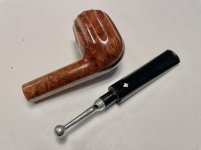This is a topic that’s been widely covered but I wondered if people might be willing to go over some of this ground again. My questions start here: What are the features of the very highest quality vulcanite factory stems? I’m curious about English pipes throughout history and whether standards changed and how much attention was paid to the top of the line stems and what makes the best ones great. I’m curious generally about comparing high-end factory stems to artisan stems. Are they comparable?
More Questions About Quality Stems
- Thread starter milk
- Start date
You are using an out of date browser. It may not display this or other websites correctly.
You should upgrade or use an alternative browser.
You should upgrade or use an alternative browser.
SmokingPipes.com Updates
Watch for Updates Twice a Week
Everything falls on a spectrum.
The word "artisan" guarantees nothing. The range runs from embarrassing crap to the best there's ever been.
The term "factory made" has no baseline or standard definition, so is essentially meaningless.
Vulcanite runs from inclusion-filled, fast oxidizing junk to still jet black and unchanged after a hundred years.
Acrylic runs from ultra-stable, gorgeous to behold, and extremely durable, to shatter-prone crumbly garbage.
The English, historically speaking, thought of stems like tires on a car, or soles on shoes... something that "served" a stummel and was expendable. The Danes, historically speaking, considered the stem and stummel to be "of a piece" that would live and die together (so to speak), so spent more time on them both comfort-wise and styling-wise.
The word "artisan" guarantees nothing. The range runs from embarrassing crap to the best there's ever been.
The term "factory made" has no baseline or standard definition, so is essentially meaningless.
Vulcanite runs from inclusion-filled, fast oxidizing junk to still jet black and unchanged after a hundred years.
Acrylic runs from ultra-stable, gorgeous to behold, and extremely durable, to shatter-prone crumbly garbage.
The English, historically speaking, thought of stems like tires on a car, or soles on shoes... something that "served" a stummel and was expendable. The Danes, historically speaking, considered the stem and stummel to be "of a piece" that would live and die together (so to speak), so spent more time on them both comfort-wise and styling-wise.
They say Dunhill focused on stems. Is it true? And if so, was it true from the beginning? I’m curious how people would order the English biggies in terms of their stem-work. I also have questions about other countries such as this: Peterson has more expensive and less expensive pipes and the inescapable P-lip. Is the P-lip on a Terracotta or House Pipe the same as one on a junior? I’ve noticed that Peterson vulcanite stems are very durable.Everything falls on a spectrum.
The word "artisan" guarantees nothing. The range runs from embarrassing crap to the best there's ever been.
The term "factory made" has no baseline or standard definition, so is essentially meaningless.
Vulcanite runs from inclusion-filled, fast oxidizing junk to still jet black and unchanged after a hundred years.
Acrylic runs from ultra-stable, gorgeous to behold, and extremely durable, to shatter-prone crumbly garbage.
The English, historically speaking, thought of stems like tires on a car, or soles on shoes... something that "served" a stummel and was expendable. The Danes, historically speaking, considered the stem and stummel to be "of a piece" that would live and die together (so to speak), so spent more time on them both comfort-wise and styling-wise.
To kind of scab on this thread, I own a very early WDC Giant Wellington with what must be a giant, pre moulded, vulcanite stem that still shows mold marks. The lettering was moulded in.
It’s extremely high grade vulcanite. It’s still black and satiny and glows after a hundred years.
Let’s say we are suppliers of stems.
How much more was the best grade of hard rubber than the cheapest?
It’s extremely high grade vulcanite. It’s still black and satiny and glows after a hundred years.
Let’s say we are suppliers of stems.
How much more was the best grade of hard rubber than the cheapest?
They say Dunhill focused on stems. Is it true? And if so, was it true from the beginning? I’m curious how people would order the English biggies in terms of their stem-work.
All large scale, long-surviving companies, British or otherwise, have been through "quality phases."
As a general thing, Dunhill's "from rod stock only" policy resulted in better stems than their competition. Their shaping was fairly consistent through the 1960's, went clunky in the '70's, recovered significantly (about 70% of the way back) in the 80's through the early 2000's, and then I stopped paying attention.
Charatan’s Make and Upshalls can be very problematic, especially when it comes to sunlight. Over time, I have grown to prefer Lucite. low maintenance means so much more as you grow older. I do think a pipe is also measured by the quality of its stem as well as its bowl.
I don’t own any lucite and I feel pretty stuck on vulcanite, as it were. That said, I don’t think I own any really especially nice specimens. But I took some advice last year and put all my pipes away. I used to have them sitting on my desk. It’s funny: my pipes are more in my imagination than in front of me.Charatan’s Make and Upshalls can be very problematic, especially when it comes to sunlight. Over time, I have grown to prefer Lucite. low maintenance means so much more as you grow older. I do think a pipe is also measured by the quality of its stem as well as its bowl.
There is a great thread up from a few years ago asking people to guess from pictures which pipes are factory and which aren’t. This is another part of my question. It’s the technical features. So, in this sense, I wonder if expensive high-end factory pipes look more hand-made in terms of the buttons, shape/fit of the stem, and tenon.
If you want to know about stems, what you need to do is buy 50 to 100 pipes from different countries, different eras, different artisans. Then you'll know what you like. Then sell the ones you don't and move on. I've also settled almost exclusively on vulcanite stems.
I've got some ridiculously comfortable Stanwells from mid-century, compared to almost anything else. I'd love to try an Ivarsson from the same period, but that's never going to happen. Older Savinellis have nice flat stems. Maybe that's not an issue for you though. YMMV. For me, it's all about the bit and button. No sharp edges please. As thin as possible is good, and fairly well rounded is good. But decades of buffing will achieve that anyway. Or if a new pipe's stem isn't right, I get rid of it, or alter it with sandpaper/micro-mesh pads till it stops bugging me.The Danes, historically speaking, considered the stem and stummel to be "of a piece" that would live and die together (so to speak), so spent more time on them both comfort-wise and styling-wise.
That’s true certainly in terms of what one likes but there was a great thread a while back here with pictures and people could pick out “artisan” from factory by certain features. So, there are technical features, I gather, that distinguish these. I was kind of wondering about the expensive end of factory pipes over the years. If “artisan” pipes can be distinguished, can be picked out by obvious features, what about more expensive factory stems?YMMV
There’s nothing magical about a pipe being artisan. The magic occurs with the drilling and the fitting. An open draw with no discernable changes in the inside diameter of the channel between the bowl and the bit as well as a well made button and exit hole and you are good to go. Commercial pipes achieve this to varying degrees. An artisan hopefully does it more routinely. Other than briar quality, the rest of the pipe is appearance. Grain, finish, fitment: these are all things artisans can show off. But the magic is what is inside the pipe. This is why a Dr. Grabow will sometimes smoke as well as a Dunhill or Castello.
It seems like the person at Malaga went through a bit of effort to carve this very beautiful pipe, once upon a time - whenever that was. I just wonder why they didn't craft a bit higher quality stem. I mean, there's nothing wrong with it. It just feels a bit cheap and the button and slot seem very workman like. It doesn't match the beauty of the stummel. Also, if you're going to carve a hefty pipe, you have to have a hefty sized bit. This one is dainty.

I don't really have expensive pipes or super nice pipes but even I can tell that this 1927 Kaywoodie has a nice stem. I'm interested in why they had that quality and time and why they made those choices back then. I have to take a picture of the bit and button but it's really nicely shaped and rounded. The vulcanite feels "high class" after 96 years.


I don't really have expensive pipes or super nice pipes but even I can tell that this 1927 Kaywoodie has a nice stem. I'm interested in why they had that quality and time and why they made those choices back then. I have to take a picture of the bit and button but it's really nicely shaped and rounded. The vulcanite feels "high class" after 96 years.

Last edited:
It seems like the person at Malaga went through a bit of effort to carve this very beautiful pipe, once upon a time - whenever that was. I just wonder why they didn't craft a bit higher quality stem. I mean, there's nothing wrong with it. It just feels a bit cheap and the button and slot seem very workman like. It doesn't match the beauty of the stummel. Also, if you're going to carve a hefty pipe, you have to have a hefty sized bit. This one is dainty.
View attachment 279499
I don't really have expensive pipes or super nice pipes but even I can tell that this 1927 Kaywoodie has a nice stem. I'm interested in why they had that quality and time and why they made those choices back then. I have to take a picture of the bit and button but it's really nicely shaped and rounded. The vulcanite feels "high class" after 96 years.
View attachment 279501
A small customer is at the mercy of the supplier to pick and chose from the supplier’s price sheet.
When Kaywoodie made more high quality pipes than all other high end makers combined they could dictate to the suppliers the quality of vulcanite.
One of the things I read about was WW2 shut down the supplies of the very finest German vulcanite and then rubber went first to the war effort and last to things like pipe stems.
I wonder if the best stems today are of natural rubber?
That’s all there was, until WW2.
Hockey pucks are cheap as dirt.

The best rubber stems must be a fraction of the cost of the cheapest briar.









